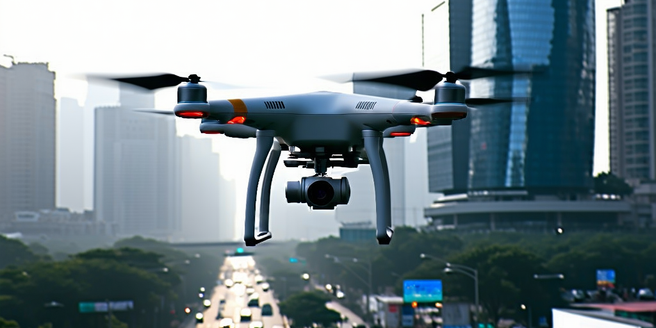Drone Delivery Systems

The Evolution of Drone Technology in Delivery Systems
Drone technology has evolved rapidly, transforming the logistics sector. Initially, drones were used for military purposes, but technological advancements have broadened their applications, including delivery. Companies like Amazon and Google have pioneered drone delivery systems, aiming to revolutionize parcel delivery by reducing transit times and costs. These UAVs (Unmanned Aerial Vehicles) are now equipped with sophisticated navigation systems, allowing them to operate autonomously and deliver packages to precise locations. The evolution of battery technology has also improved their range and payload capacity. Despite challenges like regulatory restrictions and safety concerns, the potential of drones in logistics is immense, promising faster deliveries and enhanced customer satisfaction. As technology advances, we are bound to see further improvements in drone delivery systems, making them an integral part of modern logistics.
Key Players Driving Innovation in Drone Deliveries
The drone delivery sector has attracted several key players who are driving innovation. Companies like Amazon Prime Air and Google Wing are at the forefront, experimenting with ways to make drone deliveries a common logistics solution. These companies invest heavily in research and development, focusing on technology that enhances safety and reliability. Startups like Zipline are also making significant strides, using drones to deliver medical supplies to remote areas, demonstrating the humanitarian potential of drones. Collaboration with tech companies for artificial intelligence integration and partnerships with regulatory bodies for compliance are common strategies. The involvement of these key players is vital in navigating the complexities of drone technology and in pushing the boundaries of what’s possible, striving to establish new standards in the delivery industry.
Regulatory Challenges and Solutions for Drone Operations
Operating drones in public airspace presents significant regulatory challenges. Governments worldwide are grappling with creating comprehensive frameworks that ensure safety without stifling innovation. In the U.S., the Federal Aviation Administration (FAA) has established rules governing commercial drone operations, but hurdles remain in areas like air traffic management and pilot certification. Privacy concerns and the potential for accidents also require careful consideration. To address these, stakeholders advocate for advanced air traffic management systems and clear guidelines regarding drone use. Regulations must evolve to keep pace with technological advances and industry demands. Collaborative efforts between governments, industry leaders, and international bodies are key to developing effective solutions that balance safety, privacy, and the immense potential drones offer to revolutionize delivery systems.
Environmental Impact of Drone-Based Delivery Services
Drone-based delivery services offer notable environmental benefits over traditional delivery methods. By reducing the need for vehicles, they lower greenhouse gas emissions, contributing to cleaner air. Drones are typically powered by electricity, making them a more sustainable option compared to fuel-dependent vehicles. However, the environmental impact is not completely neutral. The production and disposal of drone batteries and energy usage must be managed to minimize ecological footprints. Studies suggest that when used efficiently for short distances, drones can be more environmentally friendly. Collaborations between technology providers and environmental organizations are essential to ensure the responsible deployment of drone delivery systems. By continually assessing their ecological impact and optimizing operations, drones can serve as a green alternative in the logistics industry for a sustainable future.
The Role of AI in Enhancing Drone Delivery Efficiency
Artificial Intelligence (AI) plays a crucial role in enhancing the efficiency of drone delivery systems. AI is used to improve navigation, allowing drones to avoid obstacles and optimize flight paths for faster deliveries. Machine learning algorithms enable drones to analyze weather conditions and traffic patterns, ensuring reliable and timely deliveries. AI also helps in predictive maintenance by analyzing drone performance data to prevent potential failures and reduce downtime. Improved data processing capabilities enhance real-time decision-making, crucial for large-scale drone fleet management. By integrating AI, companies can offer smart and efficient operations, leading to cost reduction and improved service quality. As AI technology progresses, its application in drone deliveries is bound to expand, further revolutionizing the logistics industry by streamlining processes and enhancing operational effectiveness.
Future Prospects: Expanding the Reach of Drone Delivery
The future of drone delivery is poised for expansion as the technology and regulatory landscapes evolve. As urban areas become more congested, drones offer a viable solution to bypass traffic, ensuring timely deliveries. The integration of advanced technologies like AI and the Internet of Things (IoT) can facilitate the development of smarter, more efficient systems. Efforts to extend geographical reach and enhance payload capacities are underway, promising broader applications from daily parcel delivery to disaster relief operations. However, widespread adoption requires overcoming logistical, legal, and public perception challenges. Investing in infrastructure, such as drone ports and charging stations, is crucial. Despite these challenges, the prospects of drone delivery are promising, with the potential to transform the logistics industry by providing faster, more flexible, and sustainable delivery solutions.